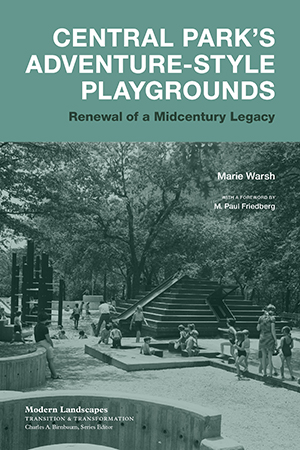
224 pages / 6.00 x 9.00 inches / 130 halftones, 10 line drawings, 1 map
Architecture / Landscape | Social Studies / Children's Studies | Sport & Recreation / Sports History
In New York’s Central Park, some of the playgrounds constructed as part of the midcentury experimental “playground revolution” still remain. In Central Park's Adventure-Style Playgrounds, Marie Warsh tells the engrossing history of these playscapes built in the 1960s and 1970s, exploring their connections to the art, recreational design, urbanism, grassroots movements, and child-development theories of the period. She further details the Central Park Conservancy’s efforts decades later to preserve and renew these playgrounds.
The so-called adventure-style playgrounds featured interconnected forms including pyramids, mounds, and steps, and basic materials such as water and sand, encouraging new levels of creativity and interaction. By the end of the 1970s, ten of Central Park’s twenty-two existing playgrounds—formerly paved, sterile, standard-equipment-filled lots dating to the 1930s—had been transformed according to the new design ideals, making the playgrounds a popular destination in the park and the city.
With time, the deterioration of adventure-style playgrounds led to concerns about their safety, and many were removed. However, community interest led the Central Park Conservancy to update and preserve those that remained in the park. Building on successful aspects of the playgrounds, designers incorporated new technologies, materials, and equipment that reflect contemporary ideas about children’s play and approaches to urban park management, developing strategies to better integrate them into the landscapes of the park. Today, Central Park’s adventure-style playgrounds represent significant works of modern landscape architecture as well as models for new thinking about playground design.
Published in collaboration with The Cultural Landscape Foundation and the Central Park Conservancy.
Marie Warsh is the historian for the Central Park Conservancy.
Renowned for his design of urban play environments, plazas, malls, and parks, M. Paul Friedberg, FASLA, also founded the urban landscape architecture program at City University of New York.
Found an Error? Tell us about it.